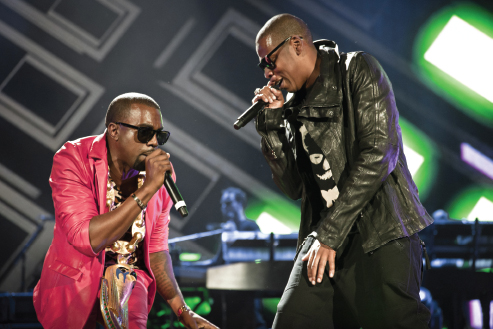Hip-Hop Redraws Musical Lines
“We’re like reporters. We give them [our listeners] the truth. People where we come from hear so many lies the truth stands out like a sore thumb.”
EAZY-E, N.W.A, 1989
With the growing segregation of radio formats and the dominance of mainstream rock by white male performers, the place of black artists in the rock world diminished from the late 1970s onward. By the 1980s, few popular black successors to Chuck Berry or Jimi Hendrix had emerged in rock, though Michael Jackson and Prince were extremely popular exceptions. These trends, combined with the rise of “safe” dance disco by white bands (the Bee Gees), black artists (Donna Summer), and integrated groups (the Village People), created a space for a new sound to emerge: hip-hop, a term for the urban culture that includes rapping, cutting (or sampling) by deejays, breakdancing, street clothing, poetry slams, and graffiti art.
Similar to punk’s opposition to commercial rock, hip-hop music stood in direct opposition to the polished, professional, and often less political world of soul. Its combination of social politics, swagger, and confrontational lyrics carried forward long-standing traditions in blues, R&B, soul, and rock and roll. Like punk and early rock and roll, hip-hop was driven by a democratic, nonprofessional spirit and was cheap to produce, requiring only a few mikes, speakers, amps, turntables, and vinyl records. Deejays, like the pioneering Jamaica émigré Clive Campbell (a.k.a. DJ Kool Herc), emerged first in New York, scratching and re-cueing old reggae, disco, soul, and rock albums. These deejays, or MCs (masters of ceremony), used humor, boasts, and “trash talking” to entertain and keep the peace at parties.

The music industry initially saw hip-hop as a novelty, despite the enormous success of the Sugarhill Gang’s “Rapper’s Delight” in 1979 (which sampled the bass beat of a disco hit from the same year, Chic’s “Good Times”). Then, in 1982, Grandmaster Flash and the Furious Five released “The Message” and forever infused hip-hop with a political take on ghetto life, a tradition continued by artists like Public Enemy and Ice-T. By 1985, hip-hop exploded as a popular genre with the commercial successes of groups like Run-DMC, the Fat Boys, and LL Cool J. That year, Run-DMC’s album Raising Hell became a major crossover hit, the first No. 1 hip-hop album on the popular charts (thanks in part to a collaboration with Aerosmith on a rap version of the group’s 1976 hit “Walk This Way”). But because most major labels and many black radio stations rejected the rawness of hip-hop, the music spawned hundreds of new independent labels. Although initially dominated by male performers, hip-hop was open to women, and some—Salt-N-Pepa and Queen Latifah among them—quickly became major players. Soon, white groups like the Beastie Boys, Limp Bizkit, and Kid Rock were combining hip-hop and punk rock in a commercially successful way, while Eminem found enormous success emulating black rap artists.
On the one hand, the conversational style of rap makes it a forum in which performers can debate issues of gender, class, sexuality, violence, and drugs. On the other hand, hip-hop, like punk, has often drawn criticism for lyrics that degrade women, espouse homophobia, and applaud violence. Although hip-hop encompasses many different styles, including various Latin and Asian offshoots, its most controversial subgenre is probably gangster rap, which, in seeking to tell the truth about gang violence in American culture, has been accused of creating violence. Gangster rap drew national attention in 1996 with the shooting death of Tupac Shakur, who lived the violent life he rapped about on albums like Thug Life. Then, in 1997, Notorious B.I.G. (Christopher Wallace, a.k.a. Biggie Smalls), whose followers were prominent suspects in Shakur’s death, was shot to death in Hollywood. The result was a change in the hip-hop industry. Most prominently, Sean “Diddy” Combs led Bad Boy Entertainment (former home of Notorious B.I.G.) away from gangster rap to a more danceable hip-hop that combined singing and rapping with musical elements of rock and soul. Today, hip-hop’s stars include artists such as 50 Cent, who emulates the gangster genre, and artists like will.i.am, Lupe Fiasco, Talib Kweli, and M.I.A., who bring an old-school social consciousness to their performances.